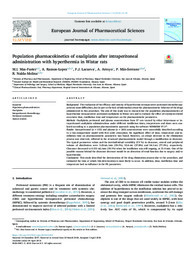Por favor, use este identificador para citar o enlazar este ítem:
https://hdl.handle.net/11000/32067Registro completo de metadatos
| Campo DC | Valor | Lengua/Idioma |
|---|---|---|
| dc.contributor.author | Mas-Fuster, M.I. | - |
| dc.contributor.author | Ramon-Lopez, A. | - |
| dc.contributor.author | Lacueva, Francisco Javier | - |
| dc.contributor.author | Arroyo, A. | - |
| dc.contributor.author | Más-Serrano, P. | - |
| dc.contributor.author | nalda-molina, Ricardo | - |
| dc.contributor.other | Departamentos de la UMH::Ingeniería | es_ES |
| dc.date.accessioned | 2024-05-06T15:01:17Z | - |
| dc.date.available | 2024-05-06T15:01:17Z | - |
| dc.date.created | 2018-04-04 | - |
| dc.identifier.citation | European Journal of Pharmaceutical Sciences, Volume 119, 1 July 2018, Pages 22-30 | es_ES |
| dc.identifier.issn | 0928-0987 | - |
| dc.identifier.uri | https://hdl.handle.net/11000/32067 | - |
| dc.description.abstract | Background: The evaluation of the efficacy and toxicity of hyperthermic intraoperative peritoneal chemotherapy presents some difficulties, due in part to the lack of information about the pharmacokinetic behavior of the drugs administered in this procedure. The aim of this study was to characterize the population pharmacokinetics of hyperthermic intraoperative peritoneal oxaliplatin in Wistar rats and to evaluate the effect of treatment-related covariates dose, instillation time and temperature on the pharmacokinetic parameters. Methods: Oxaliplatin peritoneal and plasma concentrations from 37 rats treated by either intravenous or in traperitoneal oxaliplatin administrations under different instillation times, temperatures and doses were ana lyzed according to a population pharmacokinetic approach using the software NONMEM V7.3®. Results: Intraperitoneal (n = 115) and plasma (n = 263) concentrations were successfully described according to a two-compartment model with first order absorption. No significant effect of dose, temperature and in stillation time on pharmacokinetic parameters was found. However, an abrupt decrease in the elimination process was observed, reflected in the structural pharmacokinetic model through a modification in clearance. The typical parameters values and the interindividual variability (CV %) in clearance, central and peripheral volume of distribution were 3.25 mL/min (39.1%), 53.6 mL (37.8%) and 54.1 mL (77.3%), respectively. Clearance decreased to 0.151 mL/min (39.1%) when the instillation was still ongoing, at 31.4 min. One of the possible reasons behind the clearance decrease would be an alteration of renal function due to surgery and/or hyperthermia. Conclusions: This study described the deterioration of the drug elimination process due to the procedure, and estimated the time at which this deterioration is most likely to occur. In addition, dose, instillation time and temperature had no influence in the PK parameters. | es_ES |
| dc.format | application/pdf | es_ES |
| dc.format.extent | 9 | es_ES |
| dc.language.iso | eng | es_ES |
| dc.publisher | Elsevier | es_ES |
| dc.rights | info:eu-repo/semantics/openAccess | es_ES |
| dc.rights | Attribution-NonCommercial-NoDerivatives 4.0 Internacional | * |
| dc.rights.uri | http://creativecommons.org/licenses/by-nc-nd/4.0/ | * |
| dc.subject | Population pharmacokinetics | es_ES |
| dc.subject | Oxaliplatin | es_ES |
| dc.subject | Intraperitoneal chemotherapy | es_ES |
| dc.subject | Peritoneal metastasis | es_ES |
| dc.subject | Animal models | es_ES |
| dc.subject.other | CDU::6 - Ciencias aplicadas::62 - Ingeniería. Tecnología | es_ES |
| dc.title | Population pharmacokinetics of oxaliplatin after intraperitoneal administration with hyperthermia in Wistar rats | es_ES |
| dc.type | info:eu-repo/semantics/article | es_ES |
| dc.relation.publisherversion | https://doi.org/10.1016/j.ejps.2018.04.004 | es_ES |

Ver/Abrir:
Mas Fuster_EJPS2018.pdf
1,74 MB
Adobe PDF
Compartir:
 La licencia se describe como: Atribución-NonComercial-NoDerivada 4.0 Internacional.
La licencia se describe como: Atribución-NonComercial-NoDerivada 4.0 Internacional.
.png)